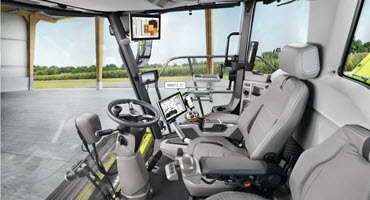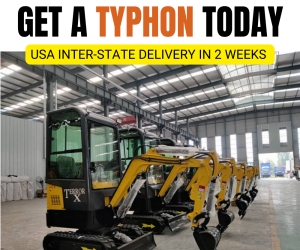How To Disrupt the Global Construction Equipment Market
Article by ALASTAIR HAYFIELD, Senior Research Director of Commercial Vehicles Division, interact analysis, and responsible for cutting-edge research on electric trucks, autonomous trucks and off-highway electrification. One of the questions I often gets asked as an analyst is “who is the Tesla of the construction equipment market?” Leaving aside the sloppy notion that Tesla is the only innovative company, I think what is meant is “who might disrupt the construction equipment market in such a way as to gain significant market share, using technology and a change in business model to do so?” Every industry faces the challenges of emissions reduction, supply chain bottlenecks and labour shortages. There is an opportunity presented by these challenges for companies to disrupt the status quo by offering a new solution or new ways of approaching the problem. The construction industry has, typically, been slow to evolve. This isn’t meant to be a criticism, rather the industry has thrived with long-established machines, processes, and solutions that ‘get the job done right and on time’. There is little time for companies and technologies that aren’t reliable or don’t provide significant value. Certain parts of the construction market have challenges that a new approach could solve. End users (construction companies) typically have low margins, and are suffering from skilled labor shortages and pressures to be more environmentally sustainable. In comparison, those companies that manufacture or sell construction equipment typically have higher margins and, generally, make sizeable profits through service and aftermarket parts. If I had to draw up a plan to disrupt the construction equipment market, this is what I would do: I would target the development of an all-electric fleet. These machines would be purposely designed to be electric from the start and would focus on maximum efficiency in hydraulics, other components, and machine material choice. This would also make the machines less expensive to operate. I would design the battery packs to be a standardized size that could be scaled based on machine size. I would also consider how these packs could be used in battery swapping and how they could be pushed into second life applications – such as mobile charging stations – at end of life. Machines would be fully connected, permitting remote updates and access to operational data, performance information, etc. This would both enable predictive maintenance and allow me to iterate future machines to have the right battery size, etc. for certain tasks. It would also enable me to manage the performance of all battery packs across machines and replace/move them based on performance. Alongside electric machines I would aggressively develop mobile charging solutions – battery packs, trailer batteries and battery shipping containers – so that end-users would be able to operate machines in as similar a way to ICE machines as possible., particularly if site power is not available. Since my machines will be electric, and in some instances fluidless, they will be much cheaper to maintain and service. This would reduce costs for both myself and end users, and also improve the operational availability of machines. I would probably want a sizeable initial fleet – 5,000 machines, say – since this would enable me to offer a service to many customers and would also give me the benefit of scale purchasing, reducing the cost of sourcing electric machines. I would negotiate a low-cost electricity rate with a utility, possibly through a partnership, to recharge batteries and provide users with a rate for their sites if they use my equipment. Initially, I would target a geography or major city that has a focus on decarbonization, ideally with a slant on construction equipment. California, Norway, the Netherlands and the UK might be good prospects. I would probably also want to target those end users with a profitability problem AND a sustainability drive. Large civils or housebuilders could be good prospects. I would want to target end users directly. There would need to be a support network to do this and getting machines to end users would be key. However, a direct-to-consumer model would reduce my overheads significantly (no dealer network to develop) and mean that I could minimize my costs. As for my business model, I might opt to charge end users based on energy usage only for the length of fixed contracts. Since electric machines are significantly cheaper to run than ICE equivalents, I could offer a daily or weekly rate that includes machines and chargers and is much lower than my competition, while maintaining a sizeable profit margin. I would probably build in a sliding fee for extensions beyond the original contract. It would incentivize end users to be as efficient as possible, since it would cost them less and motivate them to finish projects on time. This would also help me to maximise machine utilization. A lower cost wo

Article by ALASTAIR HAYFIELD, Senior Research Director of Commercial Vehicles Division, interact analysis, and responsible for cutting-edge research on electric trucks, autonomous trucks and off-highway electrification.

One of the questions I often gets asked as an analyst is “who is the Tesla of the construction equipment market?” Leaving aside the sloppy notion that Tesla is the only innovative company, I think what is meant is “who might disrupt the construction equipment market in such a way as to gain significant market share, using technology and a change in business model to do so?”
Every industry faces the challenges of emissions reduction, supply chain bottlenecks and labour shortages. There is an opportunity presented by these challenges for companies to disrupt the status quo by offering a new solution or new ways of approaching the problem.
The construction industry has, typically, been slow to evolve. This isn’t meant to be a criticism, rather the industry has thrived with long-established machines, processes, and solutions that ‘get the job done right and on time’. There is little time for companies and technologies that aren’t reliable or don’t provide significant value.
Certain parts of the construction market have challenges that a new approach could solve. End users (construction companies) typically have low margins, and are suffering from skilled labor shortages and pressures to be more environmentally sustainable. In comparison, those companies that manufacture or sell construction equipment typically have higher margins and, generally, make sizeable profits through service and aftermarket parts.
If I had to draw up a plan to disrupt the construction equipment market, this is what I would do:
- I would target the development of an all-electric fleet.
- These machines would be purposely designed to be electric from the start and would focus on maximum efficiency in hydraulics, other components, and machine material choice. This would also make the machines less expensive to operate.
- I would design the battery packs to be a standardized size that could be scaled based on machine size. I would also consider how these packs could be used in battery swapping and how they could be pushed into second life applications – such as mobile charging stations – at end of life.
- Machines would be fully connected, permitting remote updates and access to operational data, performance information, etc. This would both enable predictive maintenance and allow me to iterate future machines to have the right battery size, etc. for certain tasks. It would also enable me to manage the performance of all battery packs across machines and replace/move them based on performance.
- Alongside electric machines I would aggressively develop mobile charging solutions – battery packs, trailer batteries and battery shipping containers – so that end-users would be able to operate machines in as similar a way to ICE machines as possible., particularly if site power is not available.
- Since my machines will be electric, and in some instances fluidless, they will be much cheaper to maintain and service. This would reduce costs for both myself and end users, and also improve the operational availability of machines.
- I would probably want a sizeable initial fleet – 5,000 machines, say – since this would enable me to offer a service to many customers and would also give me the benefit of scale purchasing, reducing the cost of sourcing electric machines.
- I would negotiate a low-cost electricity rate with a utility, possibly through a partnership, to recharge batteries and provide users with a rate for their sites if they use my equipment.
- Initially, I would target a geography or major city that has a focus on decarbonization, ideally with a slant on construction equipment. California, Norway, the Netherlands and the UK might be good prospects.
- I would probably also want to target those end users with a profitability problem AND a sustainability drive. Large civils or housebuilders could be good prospects.
- I would want to target end users directly. There would need to be a support network to do this and getting machines to end users would be key. However, a direct-to-consumer model would reduce my overheads significantly (no dealer network to develop) and mean that I could minimize my costs.
- As for my business model, I might opt to charge end users based on energy usage only for the length of fixed contracts. Since electric machines are significantly cheaper to run than ICE equivalents, I could offer a daily or weekly rate that includes machines and chargers and is much lower than my competition, while maintaining a sizeable profit margin. I would probably build in a sliding fee for extensions beyond the original contract. It would incentivize end users to be as efficient as possible, since it would cost them less and motivate them to finish projects on time. This would also help me to maximise machine utilization.
- A lower cost would help construction firms to boost their margins and the use of all-electric machinery would be a significant lever in reducing Scope 1 greenhouse gas emissions.
- Over time, I would rigorously enhance the performance of my fleet using telematics data and look for ways to enhance product availability, utilization and machine health.
Is all this fantasy? Maybe. But elements of the points listed above are already in use or being examined by the construction equipment market. It won’t be long before a start-up or brave major looks to disrupt the norm to solve the problems we see today.
For more insight into the construction equipment market, reach out to Senior Research Director Alastair Hayfield. Interested in our Off-Highway research? Download our brochures:
Powered by
Induportals Media Publishing

 machineryasia
machineryasia 







